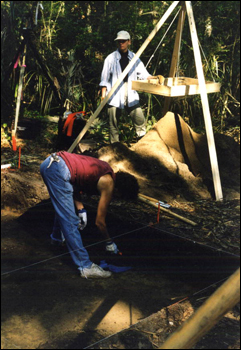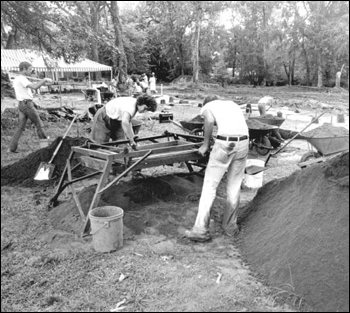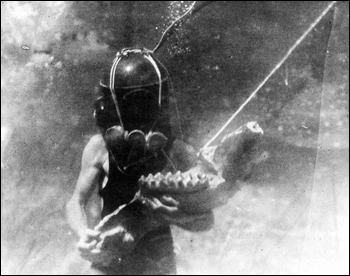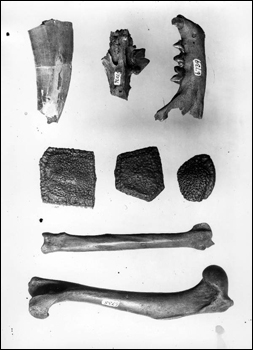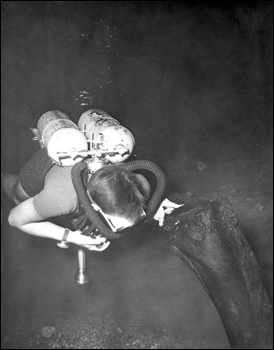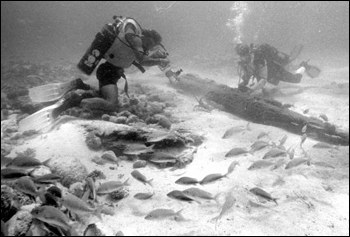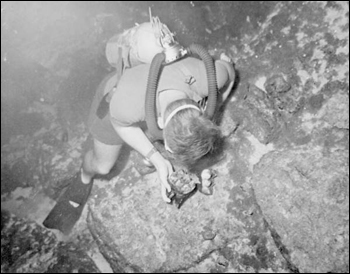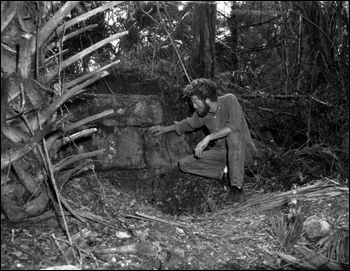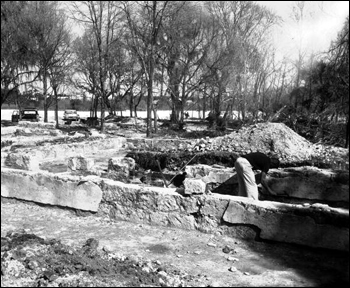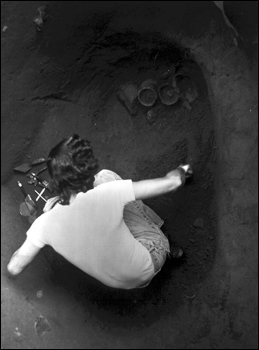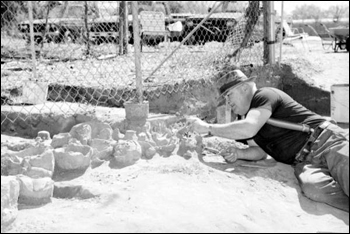Photo Exhibits
Photo exhibits spotlight various topics in Florida history, and are accompanied by brief text intended to place selected materials in historical context.
Florida Archaeology
Studying and Exploring 12,000 Years of Floridians
In the Field and Underwater
According to the Florida Bureau of Archaeological Research, Archaeology, a subfield of Anthropology (the study of humans), is the "study of past human cultures through systematic recovery of material remains such as buildings, tools, and pottery." Archaeologists examine artifacts, first and foremost in the environmental context in which they are found, to provide information about past cultures, historical events and ways in which people lived in an area. Archaeologists work in "the field" (burial sites, Indian mounds, villages and forts, etc.) and in laboratories and public spaces such as parks and museums in order to glean information and then use it to make conclusions about our shared past and educate the public.
In Florida, the environmental contexts of artifacts and the remains of human activity also includes countless fresh and salt water areas. So, "Underwater, marine, maritime, or nautical archaeology is simply archaeology done under the water. Shipwrecks are the most common type of site studied, but harbor and dock remains, fishing structures, and flooded land sites also may be investigated."
Archaeologist Vicki Rolland with volunteer college student on the University of North Florida's Sarabay Spanish Mission archaeological field school excavation on Big Talbot Island State Park : Jacksonville, Florida (1998)
Image Number: PR24735
In Spring 1998, UNF professor Dr. Robert Thunen, Keith Ashley, and Vicki Rolland conducted an archaeological survey of the southern third of Big Talbot Island. From that survey, they identified the site of 17th century Spanish mission Sarabay (the original name of the island), which was located within a Timucuan Indian village. In June 1998, they conducted the first of several excavations at the mission site using UNF students as volunteers. The photographer, a ranger at the park, was one of those volunteers.
Workers searching for items left behind from the past (1987)
Image Number: PR11402
Workers sift through mounds of dirt at the site of Hernando de Soto's 1539 winter encampment. The Trust for Public Land announced it has reached an agreement to purchase most of the site so the search for more artifacts can continue.
Diver holding lower jaw of mastodon (193-)
Image Number: PR10690
Diver is holds part of the lower jaw during recovery of a mastodon from Wakulla Springs.
The study and recovery of animal fossils unassociated with evidence of human activity is not archaeology, but paleontology. However, the interaction between now extinct late-Pleistocene large mammals such as mastodons and early human inhabitants of North America is an integral part of the archaeological record in every part of the continent including Florida, where people have explored, settled and hunted for more than 12,000 years. In many of the large freshwater springs found throughout the state, archaeologists have found evidence of prehistoric human activity such as stone tools like spear points dating from the ancient past when mastodons, mammoths, saber-tooth tigers and other large mammals still walked the through Florida's prairies and forests and swum in and drank from the springs.
Scuba diver recovering mastodon bone from Wakulla Springs (195-)
Image Number: GE0580j
Scuba diver recovering mastodon bone from Wakulla Springs (195-)
Image Number: PR10687
Marine archaeologists investigating ship wreckage : Upper Matecumbe Key, Florida
Image Number: PR12560
State underwater archaeologists investigating the wreck of the "Herrera" lying in shallow water off Upper Matecumbe Key in the Florida Keys. The ship was part of a large Spanish treasure fleet destroyed by a hurricane in July 1733.
Diver with Mastodon teeth : Wakulla Springs, Florida (195-)
Image Number: PR10536
Archaeologist working at San Marcos de Apalache Historic State Park : St. Marks, Florida (197-)
Image Number: FPS00416
San Marcos de Apalache is the second oldest surviving Spanish fortification in Florida. Built in 1680, it was located at the confluence of the Wakulla and St. Marks rivers. It was also utilized during the U.S. Civil War. The 17-acre site became a state park in 1964. It was listed on the National Register of Historic Places in 1966, and is also a National Engineering Landmark and a National Historic Landmark. The museum was built in the 1960s atop the foundation of the Civil War-era Marine Hospital, which itself was constructed from materials from the original Spanish fort.
Archaeologist working at San Marcos de Apalache Historic State Park : St. Marks, Florida (197-)
Image Number: FPS00418
Daniel T. Penton excavating a cache of Indian ceramics (1973)
Image Number: N046022
Daniel T. Penton excavating a cache of Swift Creek period (ca 3000BC-200AD) ceramics at mound 1 of the Block-Sterns site in eastern Leon County in 1973.
State Archaeologist Calvin Jones at pottery dig in southwest Tallahassee (1990)
Image Number: N038812d
Dig was located on Orange Avenue and Spring Hill Road.

 Listen: The Blues Program
Listen: The Blues Program